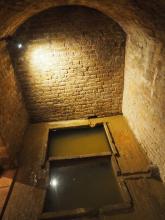Barnet Common and Physic Well
Barnet Common covered the whole area south of Wood Street including places such as Duck Island, and Underhill as far as the Dollis. Originally the area was a wood, which was cleared to form the common by the 16th century. In 1649 there was a short lived Digger community on the common, and around the same time the local clay was used for bricks.
The common was mostly used by local people to graze their animals. In 1729 the lord of the manor, the Duke of Chandos , enclosed 135 acres of the Common. In return for the loss of rights of pasture the Duke provided a charity for the poor.
This took the form of land being put aside, the rent from which would be used to buy winter fuel for the "deserving poor", called "Fuel Land". The common also provided space for the livestock brought to Barnet Fair and Market. The rest of the common was enclosed in 1815, which allowed some building to take place south of Wood Street.
Barnet Physic Well was discovered on the common during the 17th century. In 1656 the parish (who owned the well) had a well house built, and later in 1656 appointed a keeper. The well is a chalybeate spring and the effects of the water were to make the drinker urinate, which was thought at the time to help restore the body's humours back to their natural balance. So popular was the water that it was bottled and sold in London, and Barnet nearly became a spa town.
Pepys, the famous diarist, rode from London in 1664 "to see the Wells" he had a meal at the Red Lion and continued on "half a mile off; and there I drunk three glasses and went and walked, and came back and drunk two more. The woman would have had me drunk three more; but I could not, my belly being full -but this wrought me very well; and so we rode home... and my waters working at least seven or eight times upon the road, which pleased me well".
By the 1690s the well was less popular, with people helping themselves, and by 1724 Daniel Defoe wrote of the well was "formerly in great" but now "almost forgotten".
In 1808 the well was rebuilt with a subterranean arched chamber, and brought back into popular opinion by the writings of a doctor from Arkley called William Trinder. But again the well's popularity did not last, and the building was removed in 1840. The well was rediscovered in the 1920s, and in 1937 another well house was built in Well House Approach.
Barnet Council refurbished the Physic Well in 2018 to replace the roof, install lighting and a new drainage system to make the building water tight. Historic England contributed approximately 1/3 of the costs with a grant. To visit the Physic Well, please contact Barnet Museum.


